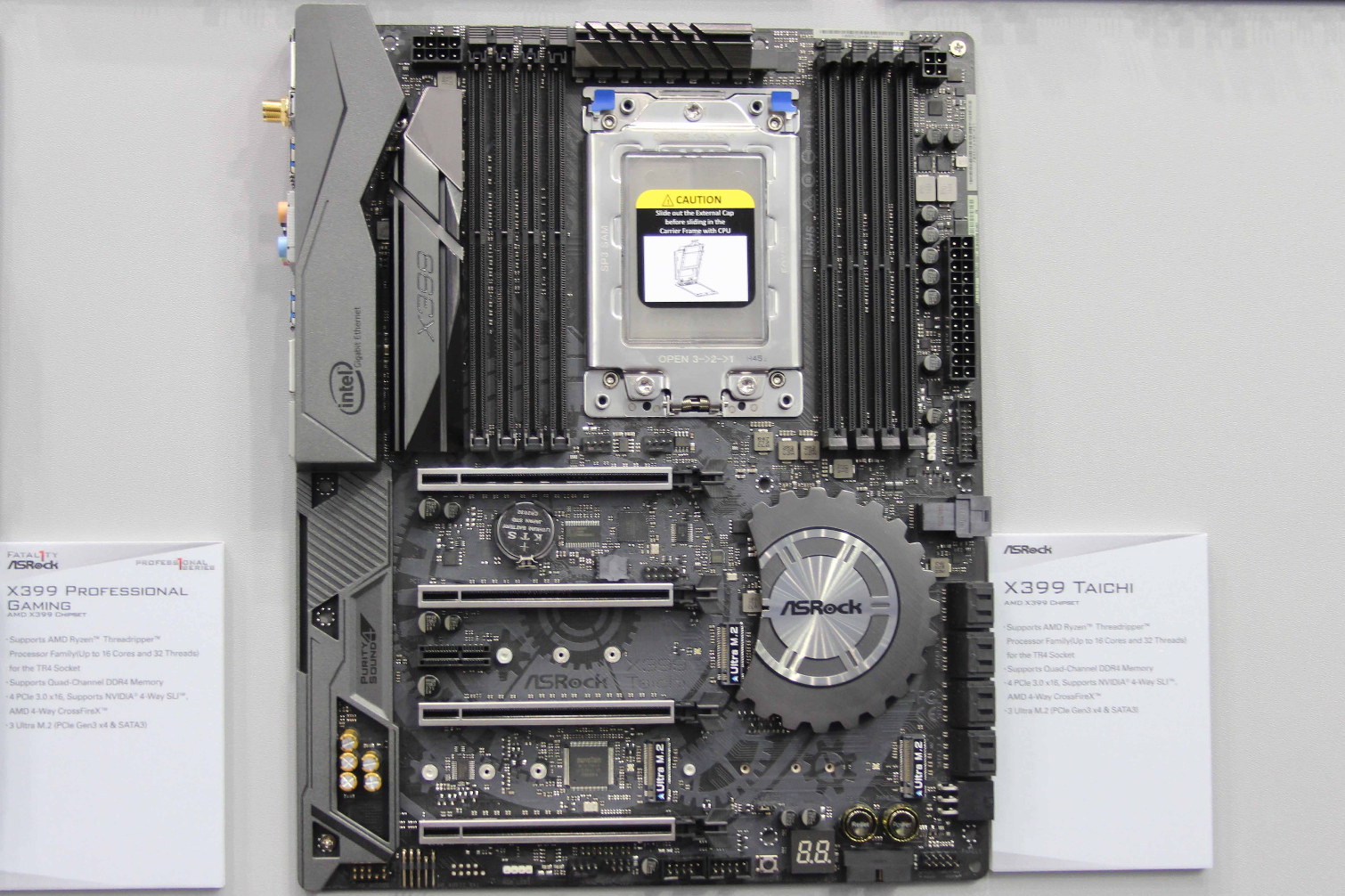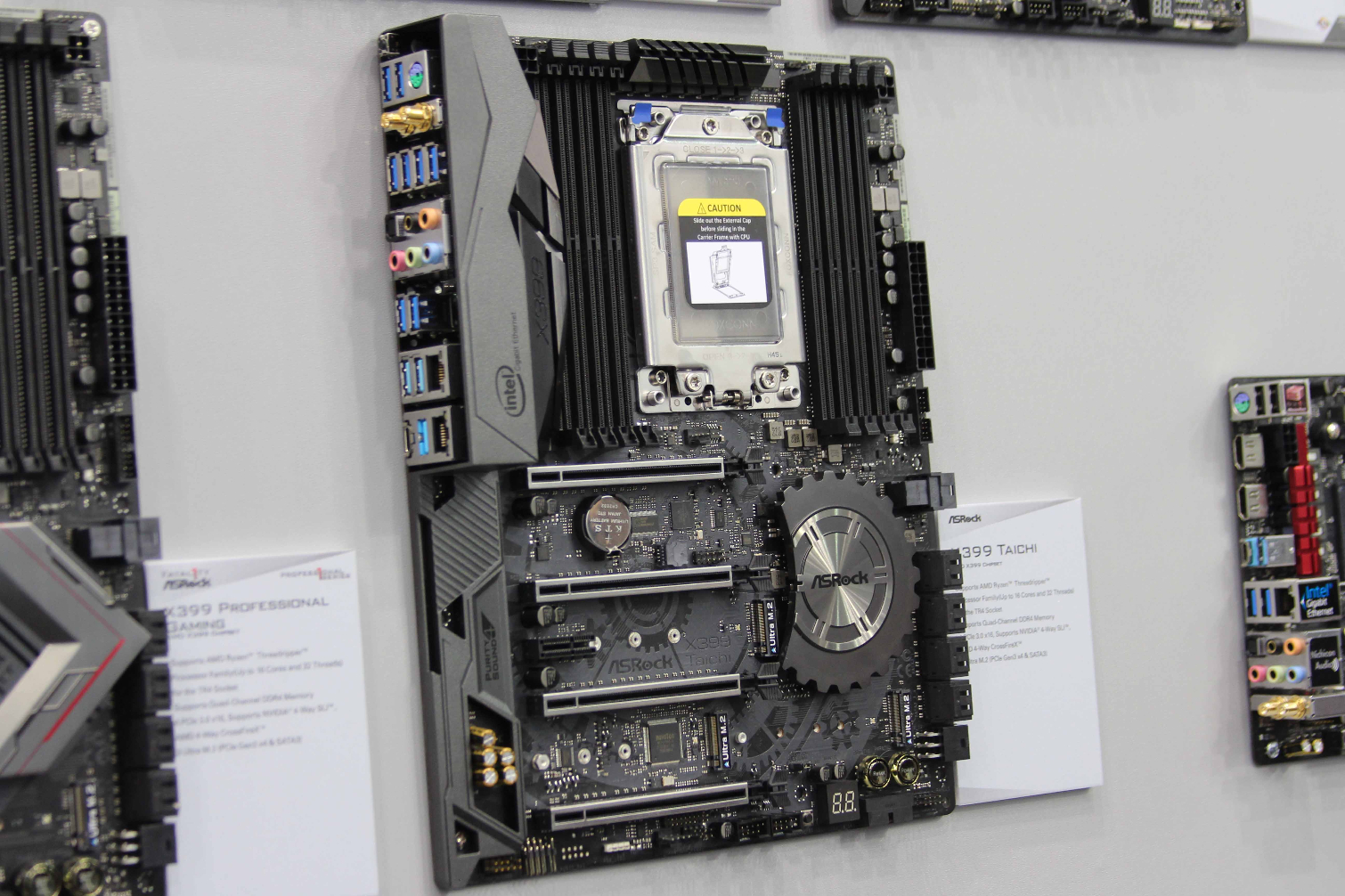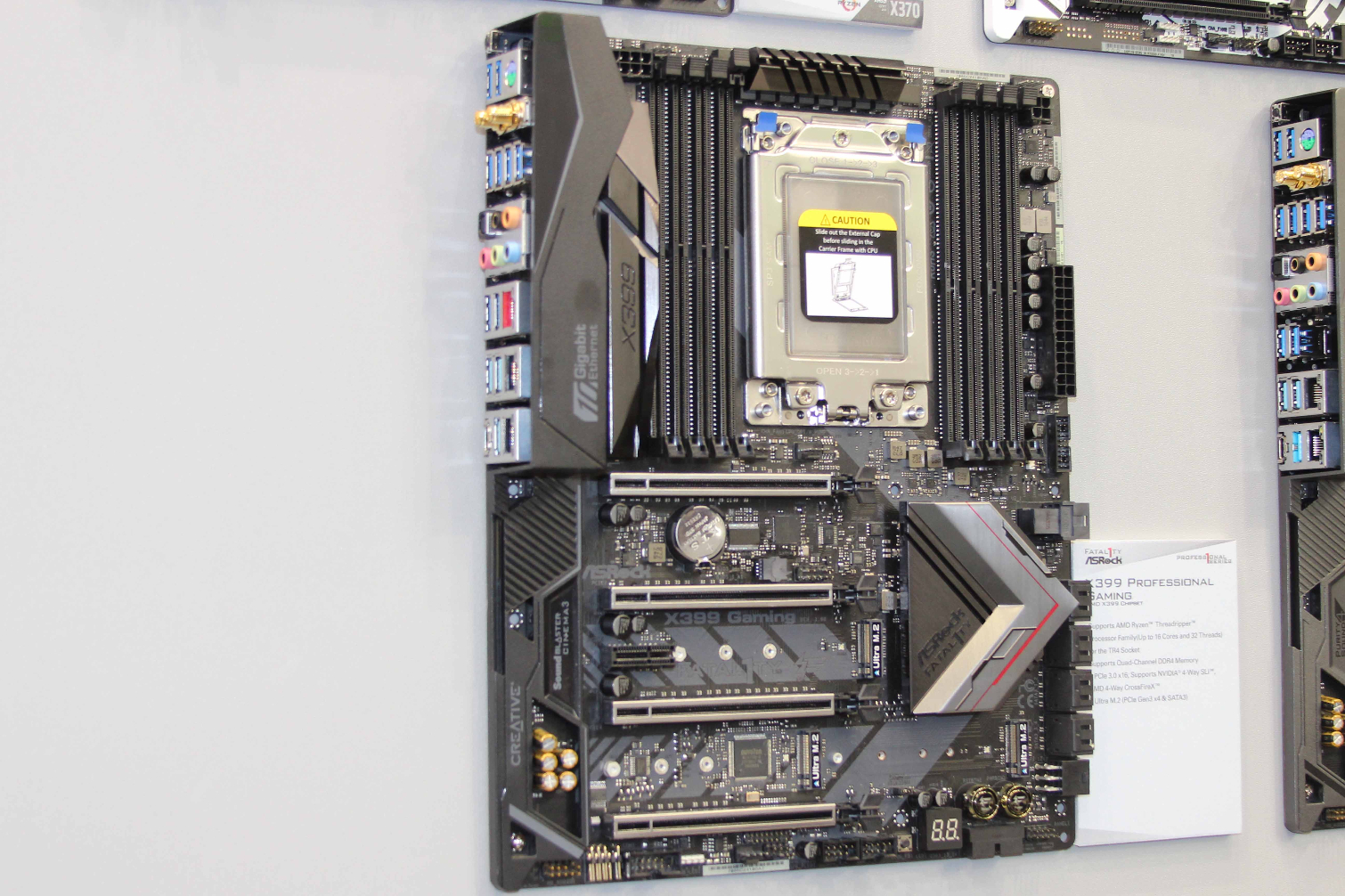ASRock Outs X399 Taichi And Professional Gaming Motherboards
ASRock had its X399 Taichi and Professional Gaming motherboards on display at Computex.
The new motherboards come sporting AMD's new 4094-pin TR4/SP3 socket that spans nearly the entire length of the eight DIMM slots. TR4 is AMD's nomenclature for the consumer-facing ThreadRipper socket, while SP3 denotes the EPYC server socket. As far as we can tell, the sockets are identical and massive. AMD's ThreadRipper will find a new home in the TR4 socket and sports 16C/32T, quad-channel memory support, and up to 64 PCIe lanes.
ASRock, like other vendors, hasn't shared much information on the new X399 motherboards, but we know the Professional Gaming supports four PCIe 3.0 x16 connections, so if your wallet can accommodate it, Nvidia 4-Way SLI and AMD's 4-Way CrossFireX are on the menu. The Professional Gaming also includes three PCIe 3.0 x4 M.2 sockets and the now-ubiquitous U.2 SSD port.
On the ends of the TR4 socket, we also spot the three large Torx screws that hold the massive ThreadRipper processor snugly in place. Notably, AMD chose to transition from a PGA (Pin Grid Array) design used for Ryzen processors to an LGA (Land Grid Array) for TR4.
The X399 Professional Gaming, like its Taichi counterpart, supports both Wi-Fi and dual LAN.
The large socket squeezes in for space next to the DIMM slots, and the close proximity to the PCIe slots also presents a challenge for large air coolers. We expect water cooling will be the go-to solution for most enthusiasts, but if you go for air cooling, a powerful cooler will certainly be a requirement due to ThreadRipper's purported 180W TDP. Noctua has designed a novel heatsink mounting system that lets you offset the cooler to provide clearance for the PCIe slots. We haven't seen any TR4 water coolers at Computex.
ASRock hasn't released pricing or availability information.
Get Tom's Hardware's best news and in-depth reviews, straight to your inbox.

Paul Alcorn is the Editor-in-Chief for Tom's Hardware US. He also writes news and reviews on CPUs, storage, and enterprise hardware.
-
falchard That's a ridiculous number of USB ports. Guess that's what happens when you double the resources for peripherals.Reply -
Rookie_MIB That is one crazy big socket. Holy #*@&.Reply
Considering that the Threadripper CPUs are supposed to have 64 or so PCIe lanes, does this mean we can theoretically support 4x SLI (x8) along with 3x PCIe x4 M.2 AND a bunch of SATA drives without losing a pair of SATA drives or a random PCIe slot? My math comes up:
4x8 = 32 - GPUs
3x4 = 12 - M.2
1x4 = 4 - CPU to chipset (? or does the CPU have a dedicated 4 lane path to the chipset?)
At that rate, we've only used 48 PCIe lanes, and still have 12 more for assorted USB/Ethernet etc...
-
JamesSneed Reply19770682 said:That is one crazy big socket. Holy #*@&.
Considering that the Threadripper CPUs are supposed to have 64 or so PCIe lanes, does this mean we can theoretically support 4x SLI (x8) along with 3x PCIe x4 M.2 AND a bunch of SATA drives without losing a pair of SATA drives or a random PCIe slot? My math comes up:
4x8 = 32 - GPUs
3x4 = 12 - M.2
1x4 = 4 - CPU to chipset (? or does the CPU have a dedicated 4 lane path to the chipset?)
At that rate, we've only used 48 PCIe lanes, and still have 12 more for assorted USB/Ethernet etc...
Yeah crazy big socket for a desktop part with tons of PCIE bandwidth. You were on the right path, 4 PCIE lanes are used by the chipset to support IO, USB, etc so you have 60 PCIE lanes for everything else.
-
akamateau Threadripper will now be the CAD workstation CPU of choice. AMD is smart releasing Vega Pro first right after Threadripper.Reply
Many Architecture and Engineering firm's IT departments build out and upgrade their own workstations as employees need them. It is easier to deal with warrantee issues if all you are doing is replacing a bad component rather than taking the whole PC down for warrantee repair.
This board has Workstation written all over it. Top tier gaming is certainly one use. -
bambiboom Paul Acorn,Reply
I second the comments by akamateau as regards the excellent workstation potential of Threadripper.
There have been a few good reasons for dual Xeons or Opterons over the year: increased number of PCIe lanes, ability to use two processors with fewer cores allowing higher clock speeds, higher total RAM capacity. We have eleven Xeon systems totaling 17 CPU's for those reasons. However, the latency in synchronizing the data streams between processors and redundancy of components: having to provide space for two sockets/processors/ CPU coolers, and sets of RAM slots. Plus, anyway, many important workstation programs- such as all of Adobe CS/CC and much of Autodesk, have had limited benefit from a lot of threads. Plus, the user having to pay for the duplicate pieces is a cost/performance ratio born of necessity rather than efficiency.
There is an upcoming Threadripper 1955X 10C / 20T @ 3.6/4.0, 44 PCIe, 125W that is especially tempting. Given the probable high single-thread performance for 3D modeling, the usefulness of 20 threads in CPU rendering, and the ability to overclock, that appears potentially to be a fantastic visualization workstation processor and should have good analytical/compute, and simulation possibilities. If it's under $700, I may well have one. My hope is that there will be roomy large format WS motherboards for that big socket.
This also represents welcome competition for the upcoming LGA2066 Xeon specification and pricing. There are some signs of some level of Intel embedded marketing ossification, with the downmarket nomenclature of "Gold" and Platinum", sounding as though these are 19th Century CPU's to be sold at Woolworths or time-share condo schemes. Also, in my view, Intel already made a serious error with the i7-7820X, which has an enticing specification of 8-cores and 3.6/4.3/4.5 clock sequence for $600, but purposely disabled PCIe lanes to support only 28. That means that many users will think twice as they count the number of GPU's that will can run at x16.
Thanks AMD; finally some sign of life in the workstation world.
BambiBoom -
Gen Patton Yes am going to wait till price gets stable about two years it should be stable. until thenReply
gonna build my AMD fx 8350 with my evga 980 Ti sc 2.0. working on parts as we speak.
Down to case fans and ssd which to choose. But I am leaning towards cosair ml fans.
And mabey Kingston or Samsung 250.



